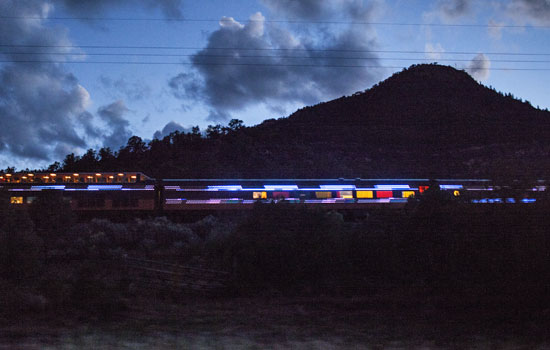
Snaking low through the desert chaparral, an animated ribbon of light pulsed through the darkness, like a lightning ball or the aurora borealis, but making almost human gestures. The long slashes of light raced forward, lingering over objects of interest, then shook in staccato bursts, pausing as though asking questions.
Seen from the desert outside Winslow, Arizona, it was apparent that Doug Aitken's piece, which he called a "nomadic light sculpture," was dancing over the outer walls of a moving train silhouetted in the full moonlight. The eight-car train was carrying his rock-tour-like art collaboration, "Station to Station," across the country from NYC to San Francisco. But this sculpture didn't behave as though it were fixed to anything. It flickered like tongues of fire.
The lights were reactive. They acknowledged the presence of a gas station and clouds that obscured the moonlight, of people, of the changing speed of the clacking wheels, of a stand of cottonwood, of the cool temperature of a river not yet run dry in the September calefaction.
"The train becomes this vehicle for light, but the light is sensitive to its surroundings," said Aitken, sitting over a busy breakfast meeting at the gorgeous La Posada Hotel in Winslow, a 1929 railway hotel stuffed with art by Ed Ruscha, Joe Goode, Tina Mion and others. "So the light and the choreography of light, the patterns and the rhythms that are created within it, are existing live and relating in real time to the surrounding environment."
It is, he said, a generative sculpture. The long strips of LED lights fixed to the side of the train were not pre-programmed, but were triggered by sensors on the train that measured light, temperature, sound and speed and were constantly remixing live.
Aitken has worked in this mode before, designing a permanent piece for the façade of the Seattle Art Museum called, "Mirror," which went live in Spring 2013 and sequences thousands of collected still and moving images in a live mix that changes in response to pedestrian traffic, weather, the time of day.
The idea is to make an artwork that is constantly changing, which is its own life-form. And in that sense, it's living within the landscape, and it's creating a dialogue with the landscape rather than superimposing a single fixed object.
During our conversation, an army of art workers swarmed the lawns of the hotel, setting up for one of the "Station to Station," happenings. At these train stopovers, artists working with the project set up site-specific experiences; the Winslow plan included the yurts I described in my previous piece to a cactus omelette dinner by Ed Ruscha to performances by Jackson Browne (whose statue in Winslow depicts him "standing on the corner" from the Eagles' song, "Take It Easy," which he wrote), Cat Power, Cold Cave, THEESatisfaction and disco king Giorgio Moroder and Bruce Sudano, who worked together on the train to make a new high-energy dance track.
When the train was parked in front of the La Posada, the sensors responded to the lights and sounds of the live performance to create a light show that fed directly off the environment.
In Winslow, the sculpture was easy to see. But once it was moving, it was gone. If you happened to catch it as it slid through the deep and limitless night of the Southwestern deserts, then you've seen it. If not, then you missed it. It's not an artwork you can go visit.
"It's not any place at any fixed time. It's out there living on its own," said Aitken. "It's like light speeding through the arteries of the North American continent, creating these different encounters."
The choreography of the lights delighted Aitken. At some moments, he pointed out, the train was moving at maybe 80 miles per hour across the landscape and the lights jetted backwards, giving the impression that the illumination had grabbed a spot of earth and stopped, as though it were making a comment or observing that spot more closely as the rest of the train moved on.
When he got way down in the weeds of his imagination, Aitken said he thought of the piece as a zoetrope, a single-aperture viewer for spinning images; or he talked about the miles of track as unexposed film being imprinted with light images as the train rolled over.
To me, it felt like language. The piece comprised a flash of signals moving across a giant barely-tamed landscape and a populace that is compelled to try to read them. It's what humans do; we try to make sense of the signals.
The signals were fleeting. When this gargantuan, hugely expensive artwork reached San Francisco for its final happening on September 28, it was dismantled. The cars went back to the places they came from, the lights come off and it was done. It's hard to imagine that it could be re-created any time soon.
Aitken hoped that the root idea of the, "Station to Station," project, however, goes on as a kind of cultural foundation or idea network.
"But one with no real estate, with no location. Completely artist-driven and artist-curated," he said. "And the mission of it is to create a constellation of ideas. For instance, we will be making short films to come out over the next year and a half. So, in a sense, "Station to Station," is not something that happens in September; this is just one phase of it as it grows and becomes this rich place for dialogues and ideas and insights and ideas for what people are making now, not in the past."
Watch for lights moving through the night.
Photo by Alayna Van Dervort, courtesy of LUMA foundation. Video courtesy of Doug Aitken Workshop.